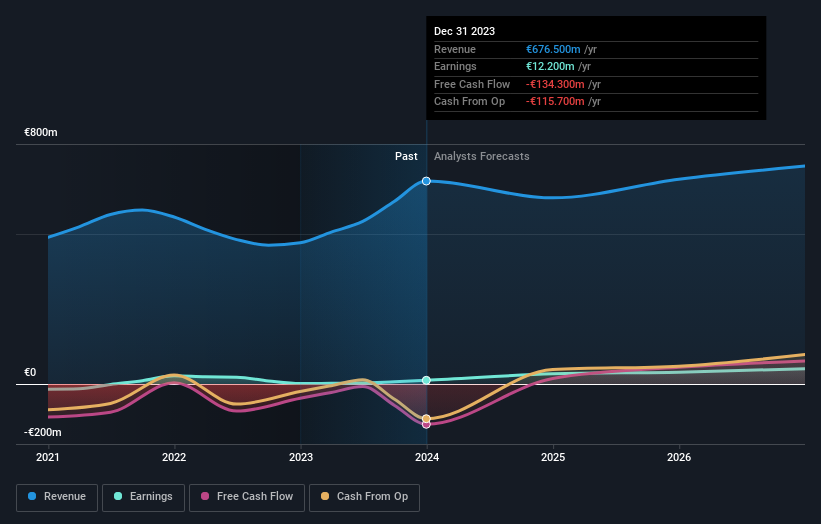Analysts Are Updating Their Talgo, S.A. (BME:TLGO) Estimates After Its Full-Year Results
Last week, you might have seen that Talgo, S.A. (BME:TLGO) released its annual result to the market. The early response was not positive, with shares down 7.1% to €4.13 in the past week. The results were positive, with revenue coming in at €677m, beating analyst expectations by 9.7%. Following the result, the analysts have updated their earnings model, and it would be good to know whether they think there's been a strong change in the company's prospects, or if it's business as usual. So we gathered the latest post-earnings forecasts to see what estimates suggest is in store for next year.
View our latest analysis for Talgo

Taking into account the latest results, the four analysts covering Talgo provided consensus estimates of €620.5m revenue in 2024, which would reflect an uneasy 8.3% decline over the past 12 months. In the lead-up to this report, the analysts had been modelling revenues of €636.2m and earnings per share (EPS) of €0.27 in 2024. Overall, while there's been a minor downgrade to revenue estimates, the consensus now no longer provides an EPS estimate. This implies that the market believes revenue is more important following the latest results.
There's been no real change to the consensus price target of €4.75, with Talgo seemingly executing in line with expectations. The consensus price target is just an average of individual analyst targets, so - it could be handy to see how wide the range of underlying estimates is. Currently, the most bullish analyst values Talgo at €5.60 per share, while the most bearish prices it at €4.10. There are definitely some different views on the stock, but the range of estimates is not wide enough as to imply that the situation is unforecastable, in our view.
Taking a look at the bigger picture now, one of the ways we can understand these forecasts is to see how they compare to both past performance and industry growth estimates. We would highlight that revenue is expected to reverse, with a forecast 8.3% annualised decline to the end of 2024. That is a notable change from historical growth of 10% over the last five years. Compare this with our data, which suggests that other companies in the same industry are, in aggregate, expected to see their revenue grow 4.3% per year. So although its revenues are forecast to shrink, this cloud does not come with a silver lining - Talgo is expected to lag the wider industry.
The Bottom Line
The clear low-light was that the analysts cut their forecast revenue estimates for Talgo next year. On the negative side, they also downgraded their revenue estimates, and forecasts imply revenues will perform worse than the wider industry. The consensus price target held steady at €4.75, with the latest estimates not enough to have an impact on their price targets.
We have estimates for Talgo from its four analysts out to 2026, and you can see them free on our platform here.
And what about risks? Every company has them, and we've spotted 2 warning signs for Talgo you should know about.
Valuation is complex, but we're here to simplify it.
Discover if Talgo might be undervalued or overvalued with our detailed analysis, featuring fair value estimates, potential risks, dividends, insider trades, and its financial condition.
Access Free AnalysisHave feedback on this article? Concerned about the content? Get in touch with us directly. Alternatively, email editorial-team (at) simplywallst.com.
This article by Simply Wall St is general in nature. We provide commentary based on historical data and analyst forecasts only using an unbiased methodology and our articles are not intended to be financial advice. It does not constitute a recommendation to buy or sell any stock, and does not take account of your objectives, or your financial situation. We aim to bring you long-term focused analysis driven by fundamental data. Note that our analysis may not factor in the latest price-sensitive company announcements or qualitative material. Simply Wall St has no position in any stocks mentioned.
About BME:TLGO
Talgo
Designs, manufactures, and maintains high-speed light rail vehicles worldwide.
Fair value with moderate growth potential.
Similar Companies
Market Insights
Community Narratives





